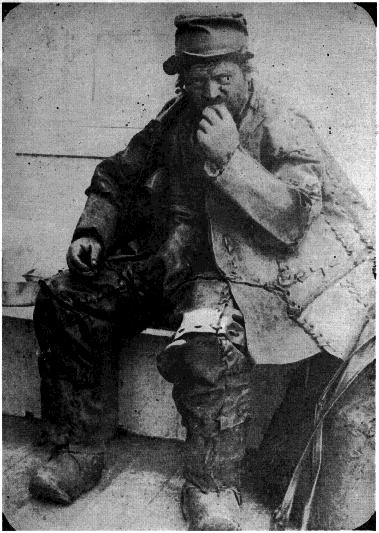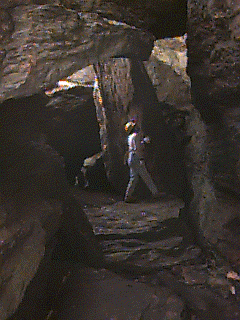
Leather Man Researcher Dan W. DeLuca has uncovered new information and it has been verified. He was not Jules Bourglay. This was a name in a story that was published in 1884, later it proven to be false and was retracted by the newspaper. Leather Man researchers Mr. Chauncey Hotchkiss, Mr. Allison Albee, Mr. Leroy W. Foote and many others all have spent much time, effort and money trying to identify the Leather Man. All were unsuccessful. All have stated that the identity of the Leather Man is Unknown. The Leather Man was a legend in his own time. He walked a clockwise circuit of 365 miles every 34 days between the Connecticut and Hudson Rivers. He died on March 20, 1889 in Mt. Pleasant N.Y., and is buried in the Sparta Cemetery just south of Ossining, N.Y. If anyone has any questions, would like to help in the research, has any information, or knows about any of the Leather Man Caves, Photographs, Paintings, or Artifacts, please contact Dan W. DeLuca _danwdeluca@aol.com (mailto:danwdeluca@aol.com) There are many articles, newspaper reports and books written about the Leather Man. Mr. LeRoy W. Foote kept the legend alive for 40 years and wrote this article in the very beginning of his research in 1952.

Litchfield County, like most of New England, is rich in native folklore. One cannot travel far in this part of Connecticut without hearing of the mysterious tale about the old Leather Man. The story is outstanding in American folklore, very typical of New England and pertains directly to the western portion of the state. It has traveled around the world.
Each person who knew the Leather Man had his own story about him and this story differed from any other. Some towns had an "official" version authenticated by the many who saw him and repeated by all, including those who never knew the Leather Man and even these stories varied from town to town. If one were to estimate the number of Leather Man stories by the people who knew this strange character, they would run into the hundreds of thousands. Unfortunately, only a small number of the stories have been preserved and some of the people now living who know him, were young when the Leather Man was alive so their memory of him is rather limited. Many attempts have been made to collect the stories but few went further than to gather the information immediately at hand.
The first scene in the Leather Man drama had its setting in Lyons, France. There seems to be nothing concrete to attest to the validity of the story and nothing of record to deny it. Like folklore of old, it has been handed down to succeeding generations and accepted as fact. There is some evidence that the story was acknowledged as true by the Leather Man himself without his uttering a word, but from one who was dedicated to a self-imposed silence, perhaps a verbal denial was too much to expect.
Early in the nineteenth century a young couple, named Bourglay, lived in Lyons and a son, Jules, met and fell in love with Margaret Laron, the daughter of a leather merchant. Bourglay was a wood carver and because of a difference in the social levels of the two families Laron objected to the match. A conference between Laron and young Jules produced a seemingly workable solution whereby Jules was to be taken into the leather firm and, on the condition he made good, would be given the hand of the fair maiden.
The arrangement worked well, as the young man proved to be worthy and a good addition to the firm. His capabilities earned him promotion and greater responsibilities to the extent that he was a purchaser of leather. His future seemed assured and the wedding date was not far off when one day in 1855 the price of leather dropped about forty per cent overnight. Perhaps a background of years of experience was lacking as Jules wrestled with the new problem. He overbought in stock with the result the firm of Laron, the leather merchant, was wrecked. Poor Jules had brought ruin on himself and those he loved and in despair he was found wandering about the streets of the city. He was placed under the care of a physician and after two years disappeared and was never seen in France again.
A chapter is missing and we are allowed onloy to conjecture what took place. About this time a man was seen walking through the town of Harwinton wearing an outfit of leather patches. This may have brought a comment from bystanders but it produced a sensation when a month later he returned. Who was he? A bold resident inquired of him but no response was forthcoming and for want of a name the stranger was called, very appropriately, "The Leather Man." Some years later it was learned that the Leather Man was none other than Jules Bourglay, the unfortunate young man of Lyons.
Considerable inquiry was made concerning him and in time he became accepted for what he was, an itinerant who asked for food and wished to be left alone. His wishes were acceded to but some residents, more curious than others, took the time to learn more about him. It was found that he had a circuit of 365 miles that he covered every thirty-four days and slept at night in caves. He traveled in a clockwise direction, never once retracing his steps. From Harwinton his route took him to Bristol, Forestville, Southington, Kensington, Berlin, Middletown and south along the westerly side of the Connecticut River to the shore towns, thence westerly to Westchester County in New York state and without crossing the Hudson, turned easterly into Connecticut near Ball's Pond. From Danbury he went northerly to New Milford, to Roxbury, Woodbury, Watertown, Plymouth and back to Harwinton, thus completing his cycle.
The Leather Man era covered almost a third of a century. It began before Lincoln was president and continued until 1889. To some he appeared to be going all the time when actually he traveled only ten miles a day taking ample time for rest and refreshment. Little children, to whom the Leather Man was pointed out on his first trips through, became of age and had families of their own and in turn may have pointed him out to their children. He became know as the "old" Leather Man because it seemed as if he traveled on forever. In time, the weight of years was noticeable. The blizzard of 1888 was too much of an ordeal even to one as hardened to the road and the weather as he and for the first time in memory of any one living he fell four days behind schedule. The rigors of that winter were such as to slow his ardor for travel and the following March he passed away on the George Dell farm in Briarcliff, New York. One of the parkways leading out of New York City is within sight of the last cave that sheltered him.
Anecdotes of the Leather Man are rich in flavor and run the whole gamut of human emotions. Pathos is often substituted by humorous situations but a strong desire to help the needy and unfortunate is evidenced by the guardianship of hundreds for this homeless itinerant. A statement concerning his regularity of travel was, "housewives set their clocks by him." The truth of it is constantly challenged by the skeptical and yet the statement, coming from many sources, persists. How can people believe that one so carefree and apparently irresponsible could be so regular in his daily routine as to outshine the village chime that has to be regulated on occasion? The fact remains, he was regular and people knew the very day to expect him; the exact hour and almost the exact minute. Even the Leather Man could not have known the effect he had on the lives of people in scores of communities that adjusted their activities to his whims.
The Leather Man knew how to take care of himself and where to get what we (sic) wanted. He made all of his utensils and looked to kind friends for food, tobacco and matches only. A man of the out-of-doors, he knew every vagary of nature and how to deal with it. Never did he accept an invitation to sleep indoors, regardless of the inclement weather but made himself comfortable through his own ingenuity and handicraft. The question is frequently asked, "How did he keep warm in winter?" A number of people observed carefully his cave-keeping methods and took particular note of his heating plant (sic). Before leaving his cave each day an inverted "v" of small dry sticks would be placed on the "hearth" or large flat stone in the center of his shelter, needing only to be lighted on his next arrival. Additional dry wood was stored in the rock crevices within the structure. With such preparation little time was lost in starting a fire after a day's journey and soon the small area was comfortable and warm. When enough coals had accumulated to warm the hearth thoroughly, they were swept outside and the Leather man lay down on his improvised "soapstone" to sleep in a warm, if not soft, bed. Additional warmth radiated from the low overhang of rock and the sensation must have been like sleeping in a hot oven. It was sufficiently warm for him to come through every winter in good health.
Some people have not given the Leather Man due credit for intelligence but he seems to have been endowed with enough sense to establish an itinerary in a strange land, make friends of hundreds of residents and win to his heart several score of housewives who took pride in feeding him. His welcome never wore out because he sought no more than one meal in thirty-four days from any household. He had more people concerned about his food, his health and his comfort than anyone else in Connecticut. He made his tools which he carried in a great leather bag of his own make, his outfit of leather patches and sometimes did his own cooking. Whether he chose to dress in leather because it was this material that brought about his ruin, as believed by many , is subject to question. It is more likely he decided on his attire with the same careful thought he exhibited in other ways. Leather was in common use and could be had for the asking. It would shed that rain as no other material and kept him dry. When a part wore out it was replaced by another easily found patch. Although cumbersome and too heavy perhaps in summer for all-around comfort and use, it was the best to be had. Every town he passed through had at least one tannery and today each of these towns has its Leather Man's cave.
From all indications the Leather Man story will be perpetuated and remain with the best of our New England folklore. It is revived each year by the press and featured not less than six or eight times annually in western Connecticut. Only recently have libraries, museums and historical societies undertook to gather and preserve Leather Man material but the quantity accumulated thus far indicates that at some future date we shall have a voluminous record of this remarkable man in our Connecticut folklore.
